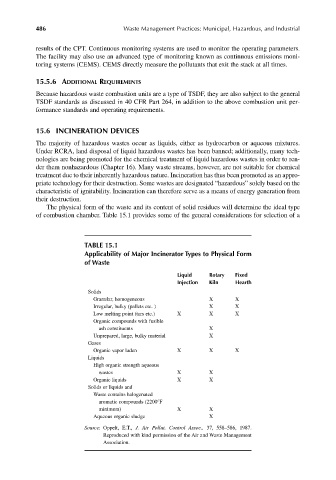Page 515 - Materials Chemistry, Second Edition
P. 515
CAT3525_C15.qxd 1/27/2005 12:40 PM Page 486
486 Waste Management Practices: Municipal, Hazardous, and Industrial
results of the CPT. Continuous monitoring systems are used to monitor the operating parameters.
The facility may also use an advanced type of monitoring known as continuous emissions moni-
toring systems (CEMS). CEMS directly measure the pollutants that exit the stack at all times.
15.5.6 ADDITIONAL REQUIREMENTS
Because hazardous waste combustion units are a type of TSDF, they are also subject to the general
TSDF standards as discussed in 40 CFR Part 264, in addition to the above combustion unit per-
formance standards and operating requirements.
15.6 INCINERATION DEVICES
The majority of hazardous wastes occur as liquids, either as hydrocarbon or aqueous mixtures.
Under RCRA, land disposal of liquid hazardous wastes has been banned; additionally, many tech-
nologies are being promoted for the chemical treatment of liquid hazardous wastes in order to ren-
der them nonhazardous (Chapter 16). Many waste streams, however, are not suitable for chemical
treatment due to their inherently hazardous nature. Incineration has thus been promoted as an appro-
priate technology for their destruction. Some wastes are designated “hazardous” solely based on the
characteristic of ignitability. Incineration can therefore serve as a means of energy generation from
their destruction.
The physical form of the waste and its content of solid residues will determine the ideal type
of combustion chamber. Table 15.1 provides some of the general considerations for selection of a
TABLE 15.1
Applicability of Major Incinerator Types to Physical Form
of Waste
Liquid Rotary Fixed
Injection Kiln Hearth
Solids
Granular, homogeneous X X
Irregular, bulky (pallets etc. ) X X
Low melting point (tars etc.) X X X
Organic compounds with fusible
ash constituents X
Unprepared, large, bulky material X
Gases
Organic vapor laden X X X
Liquids
High organic strength aqueous
wastes X X
Organic liquids X X
Solids or liquids and
Waste contains halogenated
aromatic compounds (2200°F
minimum) X X
Aqueous organic sludge X
Source: Oppelt, E.T., J. Air Pollut. Control Assoc., 37, 558–586, 1987.
Reproduced with kind permission of the Air and Waste Management
Association.

